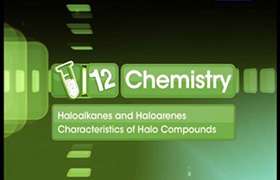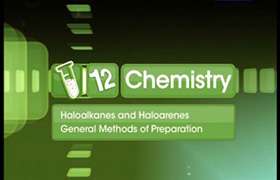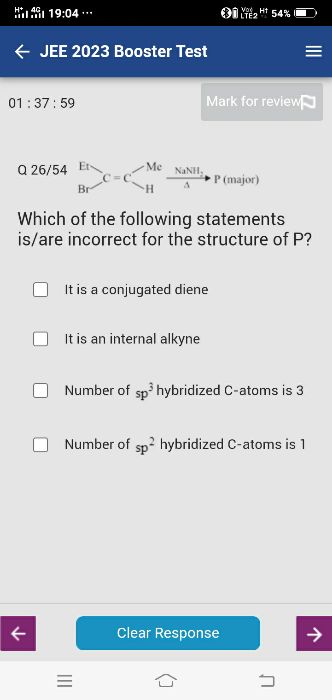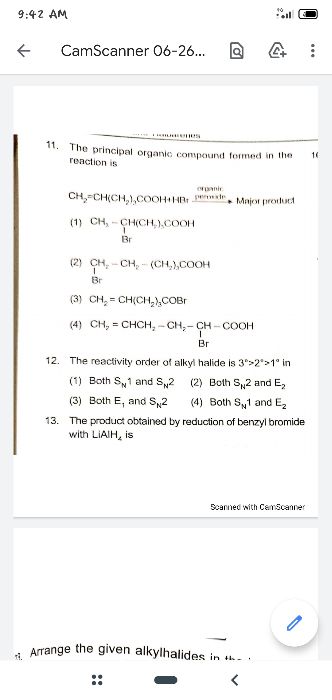CBSE Class 12-science Answered
Sn1 reaction is a substitution reaction in organic chemistry, where, Sn stands for nucleophilic substitution and 1 is the rate determining factor denoting that it is unimolecular.

Hydrolysis of tert-butyl bromide with water forming tert-butyl alcohol:
The SN1 reaction takes place in three steps:
1. Tert-butyl carbocation is formed by separating a leaving group (a bromide anion) from the carbon atom. This step is slow and reversible.

2. Nucleophilic attack: the carbocation reacts with the nucleophile. A third step is required to complete the reaction if the nucleophile is a neutral molecule (a solvent). If the solvent is water, the intermediate is an oxonium ion. This is a fast step in the reaction.

3. Deprotonation: Water which acts as a base removes a proton on the protonated nucleophile to form alcohol and a hydronium ion. This is a fast step as well.

Sn2 Reactions
* The SN2 reaction is also known as bimolecular nucleophilic substitution.
* It is a type of nucleophilic substitution, where a lone pair from a nucleophile attacks an electron deficient electrophilic center and bonds with it, leaving behind what may be called as a leaving group. So, the leaving group is replaced by the incoming group in the very first step.
* Such reactions are named as bimolecular nucleophilic substitution because two reacting species are involved in this process. It is a slow and rate-determining step.
* The SN2 reaction is known as the interchange mechanism among inorganic chemists.
Example:
Here, in this reaction, OH− (nucleophile) attacks on a bromoethane (electrophile) resulting in ethanol, with the ejection of bromide (leaving group):

Distinction between SN2 and SN1reactions
|
Factors |
SN2 Reactions |
SN1 Reactions |
|
1. Number of steps |
Θ Θ One: R : L + : Nu → R : Nu + L |
Slow Two: 1. R : L ————→ R+ + : L Fast 2. R+ + Nu– ———→ R : Nu |
|
3. Reaction rate and order |
Second order: Rate ∝ [Substrate] [Nucleophile] or Rate = K2[RL][:Nu] |
First order: Rate ∝ [Substrate] or Rate = K1[RL] |
|
4. Molecularity |
Bimolecular |
Unimolecular |
|
5. TS of slow step |
δ– δ– : Nu – – – C – – – : L |
δ+ δ– : Nu – – – C – – – : L – – – Nu : |
|
6. Reacting nucleophile |
The carbon of the substrate is attacked by the nucleophile, exclusively from the back side. |
The nucleophile can attack the carbon of the substrate from both sides. However, the attack from the back side predominates. |
|
7. Stereochemistry |
Complete inversion of configuration takes place. |
Inversion and retention takes place. |
|
8. Reactivity order of alkyl halides |
Methy l>1°>2°>3° halides. (I>Br>Cl>F) |
3°>2°>1° > methyl halides. (I>Br>Cl>F) |
|
9. Rearrangement |
No rearranged product is formed (except for allylic). |
Rearranged products can be formed. |
|
10. Nature of nucleophiles |
Favoured by strong and high concentration of nucleophiles. |
Favoured by mild and low concentration of nucleophiles. |
|
11. Polarity |
Favoured by solvents of low polarity. |
Favoured by solvents of high polarity. |
|
12. Reaction rate determining factor |
By steric hindrance. |
⊕ By electronic factor (stability of R). |
|
13. Catalysis |
Not catalysed by any catalyst (phase transfer). |
Catalysed by Lewis and Bronsted acids, e.g., ⊕ Ag, AlCl3, ZnCl2 and strong HA. |









